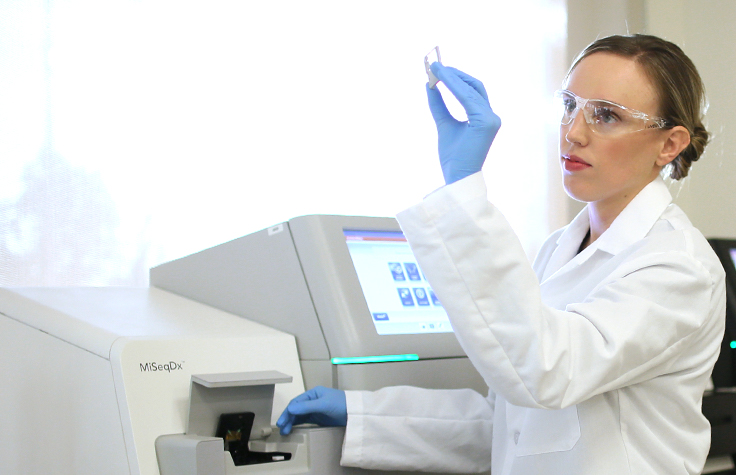分子診断
Accessing Genomics for Better Human Health
Advances in genetic analysis tools for molecular diagnostics are revolutionizing the practice of medicine, improving prenatal and reproductive care, enabling earlier disease detection, and advancing treatment of heritable disease. Novel assays based on next-generation sequencing and microarray technologies are being developed, helping us unlock the power of the genome. When laboratories begin to take advantage of these tools, we will see changes in health care in ways never before imagined, ultimately paving the way to improving human health.
NGS Resources for Pathologists
This document presents a collection of educational resources about applying NGS.
View PDF
Flexible Power for Molecular Diagnostics
The MiSeqDx instrument is the first FDA-regulated and CE-IVD-marked in vitro diagnostic (IVD) next-generation sequencing (NGS) system. Designed specifically for the clinical laboratory environment, the MiSeqDx instrument is a benchtop sequencer that incorporates an easy-to-follow workflow and an integrated software design to enable sample tracking, user traceability, and results interpretation.*
Built on Illumina sequencing by synthesis (SBS) chemistry, the MiSeqDx instrument provides accurate, reliable screening and diagnostic testing, providing the speed and accuracy to enrich human understanding of disease, enabling earlier detection and reducing the time to diagnosis. Illumina offers a growing menu of assays and kits enabling clinical laboratories to create and deploy NGS-based molecular diagnostic tests for cystic fibrosis, colorectal cancer, and a wide range of other applications.
Companion Diagnostic for Colorectal Cancer
The Extended RAS Panel is the first FDA-approved NGS test that can detect multiple RAS gene mutations for colorectal cancer in a single test. The panel assesses 12 codons in KRAS/NRAS simultaneously to determine the presence of 56 clinically relevant mutations. The test is indicated to aid in the identification of patients with colorectal cancer for treatment with Vectibix® (panitumumab) based on the absence of detected mutations. The Extended RAS Panel is intended to be used on the Illumina MiSeqDx instrument.
Guidelines for Evaluation of Colorectal Cancer
The Extended RAS Panel meets the newly published guidelines from the American Society for Clinical Pathology, College of American Pathologists, Association for Molecular Pathology, and American Society of Clinical Oncology for the evaluation of RAS mutations in colorectal cancer samples.
View PublicationCystic Fibrosis
Early diagnosis and treatment of cystic fibrosis can improve both survival and quality of life.1 However, current CF testing methods focus on CFTR variants most commonly found in Caucasians, potentially missing causative variants in other demographics.
To address these challenges, we offer TruSight Cystic Fibrosis, a consolidated next-generation sequencing solution for cystic fibrosis testing. This solution provides accurate results for an ethnically diverse population, eliminating demographic bias.
IVD Assay Development
Take advantage of powerful NGS technology by building your own IVD assays with the MiSeqDx instrument and TruSeq Custom Amplicon Kit Dx. Together, the MiSeqDx instrument and TruSeq Custom Amplicon Kit Dx provide the accuracy and reliability needed to bring NGS into clinical labs. As a result, you can increase the number of molecular diagnostic applications available to your customers.
Interested in receiving newsletters, case studies, and information on new applications? Enter your email address.
*Detailed results reports are available for the TruSight Cystic Fibrosis 139-Variant Assay, the TruSight Cystic Fibrosis Clinical Sequencing Assay, and the Extended RAS Panel.
References
- Rock MJ, Levy H, Zaleski C, Farrell PM. Factors accounting for a missed diagnosis after newborn screening. Pediatr Pulmonol. 2011;46(12):1166–1174.